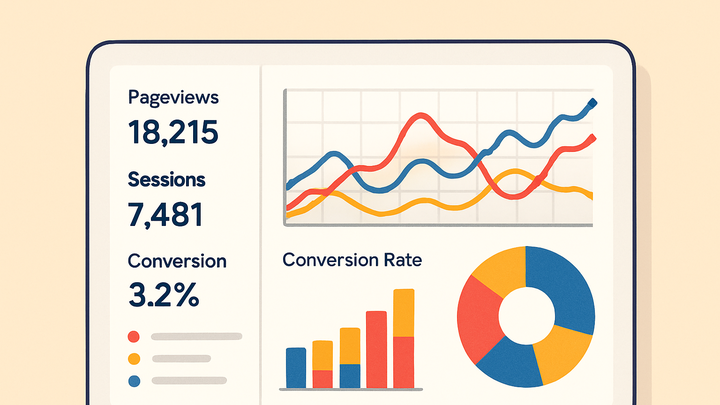Published on 2025-06-22T03:45:18Z
What is a Metric in Analytics? Examples in PlainSignal and GA4
Metrics in analytics are quantitative measures that capture specific aspects of user behavior and website performance. From pageviews and sessions to conversion rates and bounce rates, metrics provide the raw data that businesses analyze to assess progress toward their goals. By tracking these numerical indicators over time, organizations can identify trends, spot anomalies, and make data-driven decisions. Metrics are foundational for creating dashboards, setting benchmarks, and defining Key Performance Indicators (KPIs). With analytics platforms like PlainSignal and Google Analytics 4 (GA4), teams can collect, visualize, and interpret metrics efficiently to optimize marketing efforts, improve user experience, and drive growth.
Metric
A measurable numeric value in analytics used to track performance and inform decisions, from pageviews to conversion rate.
Definition and Purpose
Metrics are the fundamental building blocks of analytics, representing numerical measurements of user interactions and system performance. They help organizations understand what is happening on their digital platforms and assess progress toward goals.
-
Quantitative measurement
A metric is a numeric value that represents a specific aspect of user behavior or system performance, such as pageviews or active users.
-
Performance indicator
Metrics serve as indicators that reflect the health and efficiency of digital strategies and campaigns.
-
Benchmarking and tracking
By recording metrics over time, teams can benchmark performance, identify trends, and detect anomalies.
Types of Metrics
Metrics can be categorized by their relevance and impact on business objectives, ranging from surface-level counts to deeply actionable insights.
-
Vanity metrics
Superficial metrics that may appear impressive but don’t directly measure business success.
-
Example: total pageviews
High pageview counts may not reflect true user engagement or conversions.
-
-
Engagement metrics
Metrics that gauge how users interact with content and features.
-
Example: session duration
Average time users spend interacting with your site or app.
-
-
Actionable metrics
Metrics that guide decisions and drive improvements in product and marketing strategies.
-
Example: conversion rate
Percentage of visitors completing a desired action, like a purchase or signup.
-
Implementing Metrics in Analytics Tools
To collect metrics, insert tracking code or configure events in analytics platforms. Here are implementations for PlainSignal and GA4:
-
PlainSignal implementation
Add this script to your site’s
<head>to start capturing metrics in PlainSignal:<link rel="preconnect" href="//eu.plainsignal.com/" crossorigin /> <script defer data-do="yourwebsitedomain.com" data-id="0GQV1xmtzQQ" data-api="//eu.plainsignal.com" src="//cdn.plainsignal.com/plainsignal-min.js"></script> -
Google analytics 4 (GA4) implementation
Use the Global Site Tag with your GA4 measurement ID:
<script async src="https://www.googletagmanager.com/gtag/js?id=G-XXXXXXXXXX"></script> <script> window.dataLayer = window.dataLayer || []; function gtag(){dataLayer.push(arguments);} gtag('js', new Date()); gtag('config', 'G-XXXXXXXXXX'); </script>
Best Practices for Using Metrics
Apply metrics thoughtfully to ensure they deliver reliable insights and actionable guidance for your team.
-
Align with business goals
Choose metrics that directly reflect strategic objectives to maintain focus on outcomes that matter.
-
Maintain data quality
Regularly audit your tracking setup to prevent missing events, duplicate tags, and inconsistent naming conventions.
-
Regular audits
Periodically review your analytics configuration for accuracy and consistency.
-
Monitor sampling
Be aware of sampling thresholds in tools like GA4 to avoid skewed data.
-
-
Use contextual analysis
Interpret metrics alongside historical data, industry benchmarks, and user segments to derive deeper insights.
